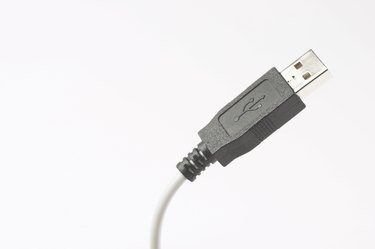
Printers offer more connection choices than ever before. In a business setting, this lets IT administrators have a great deal of flexibility in choosing who gets a printer, how many printers they should install, and what types of printers everyone can access. While it used to be that offices typically shared a single, centrally located printer, the multiplicity of connections now available enable a user to access a small desktop USB printer and also to connect to separate, high-volume black and white and color printers -- all without needing to install separate print servers.
USB
Video of the Day
Most smaller printers directly connect to a computer via the Universal Serial Bus (USB) standard. Connections using this standard have small, light cables and are ubiquitous -- available on Windows, Macintosh and Linux computers. Furthermore, because the USB connection is bidirectional, it allow printers to send data like ink levels back to the computer.
Video of the Day
Ethernet
Higher end printers typically have a built-in wired Ethernet connection for use with a local area network (LAN). Along with the LAN connection, they often contain a built-in print server. This allows other computers on the network to directly connect to the printer without it needing to be connected to another computer that serves as its controller.
Wi-Fi
Printers with built-in Wi-Fi network connections offer the same benefits that Ethernet-equipped units do, with one major difference. Since they connect to the network wirelessly, they can be placed anywhere, without needing to have a physical network-connection jack. This makes them especially good choices for workgroups that need a printer which they can share while they work together, but will ultimately move elsewhere at the end of the project.
Sharing Another Computer's Printer
Printers that do not have networking built-in can still be shared on a network via the printer sharing tools built into most operating systems. In this instance, the printer connects to a computer over USB, and the computer then shares the printer over the network. While this can be an effective way to share a non-networkable printer, it only works if that computer remains on and connected to the network at all times.
Legacy Ports
Some printers connect over older, legacy ports such as parallel and serial ports. Although modern printers no longer use parallel connections, some specialty printers, such as register tape printers, still connect over the RS-232C, nine-pin serial standard. Computers that lack parallel or serial ports can connect to these type of printers via an inexpensive USB-to-parallel or USB-to-serial adapter.